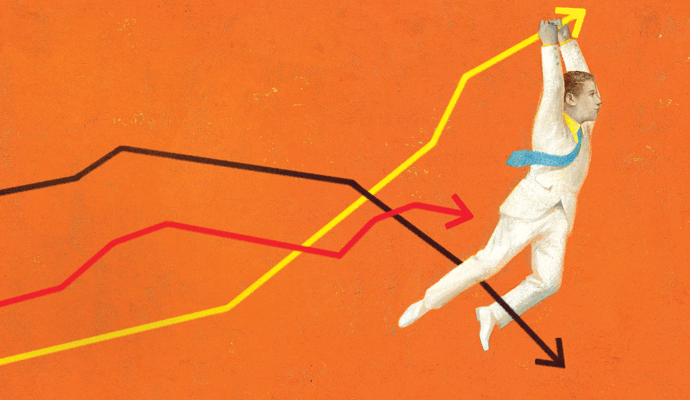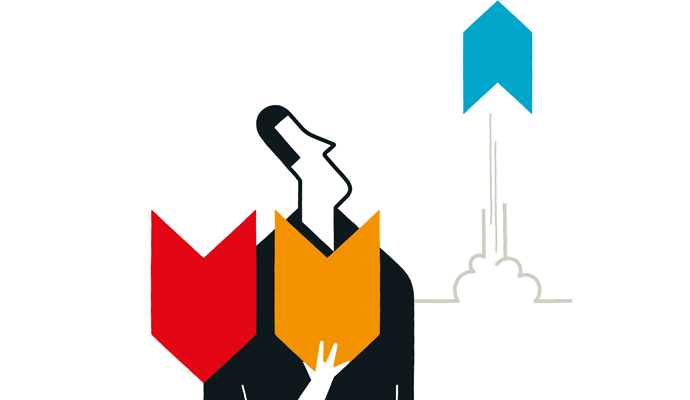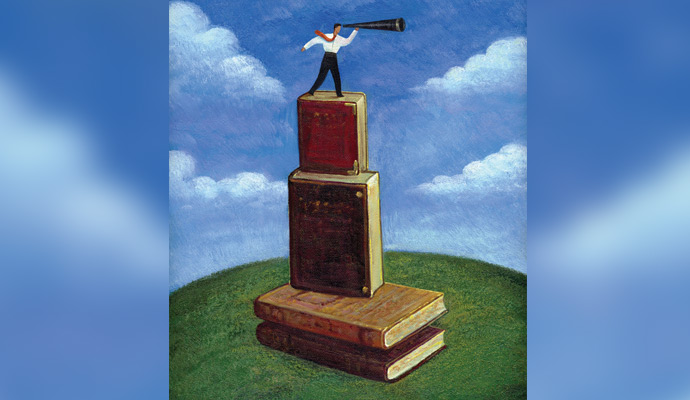Best Business Books 2015: Narratives
An Expensive Breakdown in Communications
A version of this article appeared in the Winter 2015 issue of strategy+business.
Jacquie McNish and Sean Silcoff
Losing the Signal: The Untold Story behind the Extraordinary Rise
and Spectacular Fall of BlackBerry (Flatiron Books, 2015)
Nicholas Carlson
Marissa Mayer and the Fight to Save Yahoo (Twelve, 2015)
Ashlee Vance
Elon Musk: Tesla, SpaceX, and the Quest for a Fantastic Future (HarperCollins, 2015)
There’s no shortage of analysis about what makes executives successful. And no wonder: Investors bet billions of dollars on those mysterious qualities. But the analysis often suffers from what scientists call “sampling on the dependent variable.” The lens of success is not the lens of failure. Would the same traits in a different person, in a different company, at a different time, lead to the same result? Are Steve Jobs’s notable quirks, from his trademark black turtleneck to his tyrannical treatment of employees (which are emulated by many wannabe entrepreneurs in Silicon Valley), part of what made him successful? A recipe for disaster in every other case? Or totally beside the point?
Three of this year’s best business books are narratives that tell compelling journalistic stories about famous technology executives and their storied engineering-driven companies. Jacquie McNish and Sean Silcoff’s Losing the Signal: The Untold Story behind the Extraordinary Rise and Spectacular Fall of BlackBerry, Nicholas Carlson’s Marissa Mayer and the Fight to Save Yahoo, and Ashlee Vance’s Elon Musk: Tesla, SpaceX, and the Quest for a Fantastic Future all feature extraordinary reporting and behind-the-scenes drama. But they also show that the rules don’t always apply; that media and peer adulation is often misguided; and that notable traits, both ones that we associate with stunning success and ones that we associate with go-to-jail-now failure, are not by themselves predictive of anything. Or at least, not predictive immediately.
From Addiction to Afterthought
It’s difficult to tell the story of a company when it is still in the middle of its narrative arc. But history has come pretty close to reaching a verdict on BlackBerry, the Canadian company formerly known as Research in Motion (RIM), whose devices were once considered so addictive they were known as “CrackBerries.” The company made mobile corporate email a necessity, and became the world’s largest seller of smartphones, with almost US$20 billion in revenues at its peak in 2011. But just four years later, the best it can hope for is survival. (In its most recent quarter, the company reported revenues of just $658 million.) “In the technology sector, failure is often a precondition to future successes, while prosperity can be the beginning of the end,” McNish and Silcoff, both journalists at the Globe & Mail, note.
The simple story is that the BlackBerry, which was a great innovation in its time, was rendered irrelevant by the iPhone. But the story that the authors tell in this book — the best of this year’s narratives — is more complicated. The company was created by an unlikely duo. Jim Balsillie, who grew up in a working-class neighborhood, was of both Scottish and Metis (Canadian aboriginal) descent. He was a driven and paranoid salesman whose favorite book was The Art of War and who once scored himself face time with important CEOs at a dinner by surreptitiously switching place cards. He was “terrified,” write the authors, that “carriers or competitors would one day toss the company over a cliff.” Mike Lazaridis, born in Istanbul to Greek parents who immigrated to Canada when he was a young boy, was the technical genius. His conviction that he could pull off the almost miraculous “came down to faith, a deep abiding confidence in himself and his company,” the authors write. Outside work, the two had nothing in common, and were not friends. “We don’t do that here,” Balsillie warned an executive who tried to make the management team more cohesive outside the office. “We don’t hang out together.”
Balsillie’s tactics often bordered on the dishonest, and his treatment of employees was outright abusive. “Be brief and don’t look him directly in the eyes,” one executive would advise before meetings. “You don’t know if he’s going to hug you or maul you.” Both men mercilessly pushed the engineers to deliver the impossible. The company’s internal processes and controls were a mess.
And it all worked fabulously until it didn’t. Or as McNish and Silcoff quote Mike Tyson: “Everyone has plans until they get hit.” Lazaridis’s driving principle was that mobile communications devices needed fewer features in order to optimize battery and network usage. That strategy was obliterated when the iPhone, laden with amazing features, changed consumers’ expectations. “Strategic ambiguity is death to a company,” Balsillie said in a 2009 speech. “It paralyzes organizations.”
It’s not clear whether executive dysfunction or technological obsolescence comes first.
In a version of the eternal chicken-and-egg question, it’s not clear whether executive dysfunction or technological obsolescence comes first. RIM couldn’t adapt in part because Lazaridis and Balsillie’s unlikely partnership had fallen apart owing to seemingly external events that devastated and distracted both men. Chief among them was a stock options backdating scandal caused by RIM’s sloppy controls. “You name all the great things that RIM was able to do, this thing just sucked it all out,” Lazaridis told the authors. “I mean, why bother building a great organization if this can happen to it?” In conclusion, Losing the Signal makes for painful reading as the company once again races to put out a product that can compete with the iPhone on a schedule that the engineers once again tell the bosses isn’t doable. And this time, it isn’t.
Looking through a Portal
Back in 2006, when RIM was still on top of the world, a Yahoo employee wrote a critique of his then 12-year-old company and its strategy. “We lack a focused, cohesive vision for our company,” he wrote. “We want to do everything and be everything — to everyone…we are reactive instead of charting an unwavering course.” It was dubbed the “Peanut Butter Manifesto,” because the executive argued that the company’s resources were spread too thin. Whereas RIM lost its focus, it’s not clear, judging from Nicholas Carlson’s Marissa Mayer and the Fight to Save Yahoo, that Yahoo ever had one. “Ultimately, Yahoo suffers from the fact that the reason it ever succeeded in the first place was because it solved a global problem that lasted for only a moment,” writes Carlson, a correspondent at Business Insider whose long feature on Mayer served as the basis for this book.
Yahoo was founded in the early days of the Internet, before the advent of search engines, when two Stanford students, Jerry Yang and David Filo, started Jerry’s Guide to the World Wide Web, a simple listing of sites. Companies desperate to get their names in front of users threw advertising dollars at Yahoo — a result that eventually became detrimental. “Fish had jumped out of the water and into the boat, so no one inside the company had bothered to learn how to do things like bait a hook or throw a line in the water,” Carlson writes. After the first dot-com collapse, Yahoo was reinvented as a media company under the leadership of Hollywood veteran Terry Semel. But a slightly more professional, advertising-driven strategy that appeared to be working was actually masking a serious problem. Just as BlackBerry didn’t see the iPhone coming, Yahoo failed to detect the threat that Google, based just a few miles away, would pose to its search business.
Yahoo, which one of its short-lived CEOs describes as a “complex monstrosity built without a plan,” managed to maintain an impressive market value through all the turmoil, thanks to the remarkably prescient investment the company made in 2005 in the Chinese phenomenon Alibaba. When the activist hedge fund manager Dan Loeb gained seats on Yahoo’s board in 2012, his crew brought in a star CEO to stage a turnaround of the core business.
The summer 2012 entrance of Marissa Mayer onto the scene is when Carlson’s narrative becomes about the present, not the past. Mayer has always enjoyed fantastic press. As one of the few prominent female executives at Google, she was once dubbed “Goo-Girl.” Like her male counterparts in the Valley, Mayer seems to have a preternatural faith in herself. Carlson describes how her presentation skills wowed Yahoo’s board, so much so that they overlooked her lack of experience with a profit and loss statement. When she took over, she talked about all the right things, from cutting Yahoo’s stifling bureaucracy to the importance of “pushing the teams at breakneck speed,” from adding Google-like employee perks to promulgating the fashionable idea that failure is a really good thing, as long as you fail fast. (Failure, it should be noted, is still failure.)
But even though Mayer checked all the boxes, Carlson conveys a sense that she had several drawbacks. “If this was a superhero story, it would be clear by now that, despite a few setbacks, Mayer was going to save the day,” he writes. “But this isn’t a superhero story.” Although Mayer rose high at Google, she was eventually sidelined. Among insiders at both Google and Yahoo, she became notorious for a “brutal combination” of traits. Coworkers described her as icy cold and often unwilling to look people in the eye. She was terribly late to a critical meeting with the CEO of an advertising agency whom she needed to woo. Henrique de Castro, a widely disliked former Google executive whom she hired as her number two, left after 15 months, and earned $109 million. Mayer “appeared to believe she was always right,” Carlson writes. “Mayer would respect people who stood up to her and told her she was wrong, but she wouldn’t change her mind.”
Carlson’s book suffers as a piece of analysis because he lacks clarity on his central character, sometimes to the point of parody. (Mayer didn’t cooperate with the book and Carlson didn’t interview her.) He presents Mayer as angelically self-sacrificing during her time at Google. She “knew she was fighting a turf war but she didn’t think about it in terms of power,” he writes. “She was just taking on as much as she could take on, and assumed everyone who mattered agreed it was for the best.” Really? Perhaps. Yet she threatened to quit when a rival got promoted before her. Carlson is also unclear as to whether the managerial flaws he documents so well are even the problem, or if the structural challenges Yahoo faces are to blame. “There was nothing especially abhorrent or uncommon about Mayer’s behavior as an executive,” he writes. “She was headstrong, confident, dismissive, self-promoting and clueless about how she sometimes hurt other people’s feelings. So were many of the most successful executives in the technology industry.”
Well, hello, Elon Musk!
A Supercharged Entrepreneur
Musk, the founder of Tesla Motors and a relentless evangelist for new technologies, has often been portrayed as a kind of business superhero. And in his well-reported story of Musk’s rise, Ashlee Vance, a Bloomberg Businessweek reporter, paints a nuanced, if ultimately admiring, portrait. Like the executives in the other two books, Musk lacks some of the people skills many analysts believe are necessary for great leadership. “Many of us worked tirelessly for him for years and were tossed to the curb like a piece of litter without a second thought,” a former employee tells Vance. Elon Musk: Tesla, SpaceX, and the Quest for a Fantastic Future includes a chilling episode in which he fires his longtime assistant. Like Mayer, he believes in failing fast, doing faster, and not worrying much about processes or controls. Musk’s approach is to “set overly optimistic deadlines and then try to get engineers to work nonstop for days on end to meet the goals.” And he doesn’t brook much dissent. “The kiss of death was proving Elon wrong about something,” writes Vance.
And yet, at least to date, Musk has been able to deliver. Self-made — he had a difficult childhood in South Africa before attending college in the U.S. — Musk is a stunning success “who has managed to make radical ideas the basis of his companies.” After helping create PayPal, he poured everything he had (and then some) into two new ventures that most observers viewed as folly: SpaceX, the first privately owned company to get a rocket into orbit, and the electric car company Tesla Motors. Musk is also the chairman of a solar company called SolarCity, which is run by two of his cousins. Vance, who got access to Musk and many of his confidants, quotes a host of Silicon Valley luminaries — including Google founder Larry Page and venture capitalist Peter Thiel — gushing about Musk. “Elon is one of the few people that I feel is more accomplished than I am,” said Craig Venter, who decoded the human genome.
Maybe one thing that sets Musk apart is that (in defiance of the Mike Tyson quote) he managed to keep his plans after being punched. He lost an internal battle at PayPal and was pushed out. His infant son died, his marriage fell apart, and his startups came within inches of failure. “It hurt really bad,” Musk tells Vance. “You have these huge doubts that your life is not working, your car is not working, you’re going through a divorce, and all of those things.”
“Most people who are under that sort of pressure fray,” a friend of Musk tells Vance. “Their decisions go bad. Elon gets hyperrational. He’s still able to make very clear, long-term decisions. The harder it gets, the better he gets.”
Musk also seems to have a sharp understanding not just of technology, but of what it is that makes a business. “There’s this level of engineering and physics that you need to make judgments about what’s possible and interesting,” Vance quotes Larry Page as saying. “Elon is unusual in that he knows that, and he also knows business and organization and leadership and governmental issues.”
The problem with believing that these are answers to the riddle of success is that Musk’s empire is still very much a work in progress. Vance is a veteran correspondent in Silicon Valley, where hype and hucksterism are common. He describes himself as a “cynic” about Musk’s enterprises at first. But around the middle of the book, he switches from wonderfully insightful analysis of Musk himself to simple adulation. Vance’s discussion of the business prospects of Musk’s companies often reads like it was dictated by the public relations department. He quotes Musk bragging that “Tesla could eventually be more valuable than Apple and could challenge it in the race to be the first $1 trillion company” without any dissent. Vance doesn’t pay much heed to the concerns of those who aren’t on the bandwagon. Although Tesla boasts a market capitalization of $30 billion, it has generally reported losses. Nor does Vance make anything of the extent to which his new hero of capitalism is dependent on government funds and subsidies. (Among other things, a $7,500 federal tax credit to buyers helps make Tesla vehicles slightly more affordable.) At this stage and in the industries in which Musk is competing, such support might be necessary. But surely these factors should be acknowledged.
Like Jobs’s flaws, Musk’s flaws might be incidental, or they might be his contrarian keys to success. But it’s also possible that in 10 years, you’ll read another narrative in which Musk’s flaws are viewed through a more critical lens.
Stay tuned.
Reprint No. 00374
Author profile:
- Bethany McLean is a contributing editor at Vanity Fair and a coauthor of The Smartest Guys in the Room: The Amazing Rise and Scandalous Fall of Enron (Portfolio/Penguin, 2003). Her most recent book, Shaky Ground: The Strange Saga of the U.S. Mortgage Giants (Columbia Global Reports), was published in September 2015.






